


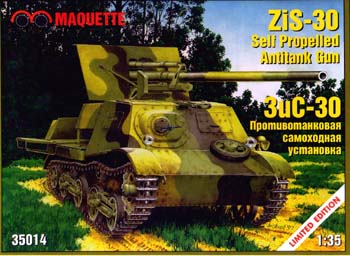 MAQUETTE'S
1/35th SOVIET ZIS-30 SELF-PROPELLED ANTI-TANK GUN ON THE "KOMSOMOLETS"
TRACTOR
MAQUETTE'S
1/35th SOVIET ZIS-30 SELF-PROPELLED ANTI-TANK GUN ON THE "KOMSOMOLETS"
TRACTOR
by Ray Mehlberger
HISTORY
During WWII, there was revealed a huge need by the Red Army for self-propelled, anti-tank artillery. Therefore, on July 1st, 1941, the People's Commissar of Arms, Vanikov, signed the order for development and manufacture of a 57mm AT gun on a self-propelled chassis. Furthermore the AT gun was to have an armored cabin. Thus, the design was widely produced by the automotive parts industry.
By the end of July 1941, two SP designs had left the factories. These were the Zis 30 and the Zis 31. The Zis 30 had a rotating 57mm AT gun, mounted on a A-20 "Komsomolets" artillery tractor (the subject of this kit). The Zis 31 was mounted on a three-axle truck....the Gaz AAA.
Comparison tests were done of the two machines in July and August. They showed that the Zis 31, when firing, was more steady and had a greater grouping of shots in comparison to the Zis 30. However, the cross-country ability of the Zis 31 was poorer than the Zis 30, so preference switched back to the Zis 30.
Troops received the first Zis 30 SP guns at the end of September 1941. All of these went to the AT batteries of tank brigades on the Western and Southwestern Fronts. In the first battles, the Zis 30 performed very well, it was said that the vehicle was rather successful in combat. However, after more use, problems with the SP gun became evident. The running gear was overloaded, it had short road range, it carried too few rounds of ammo, had too high a profile, weak engine protection, and an absence of communication between gun crew and driver. Nevertheless, in spite of these faults, the Zis 30 still successfully struggled along against enemy tanks.
In the summer of 1942, there were no more Zis 30s in operation with the Soviet forces. Most of them had been lost in battle, and the balance were out of operation due to breakdowns and lack of spare parts.
A total of 101 Zis 30's were produced during the war and they were supplied to 20 different Soviet tank brigades.
What is in the box?:
This kit is marked as a "LIMITED EDITION". I have been told, by armor modeling friends, that this is true and few will be available of it. I got mine in trade with my friend Mitsu in Tokyo.
Four cello bags of parts trees are in the box. One cello bag holds three medium sized, light gray plastic trees. A second cello bag holds two smaller trees of the same color plastic. The third cello bag contains a small, slightly lighter gray tree and a even smaller chalk white tree. The final, fourth cello bag, holds two medium sized trees of olive gray parts. Many of these parts had been broken off, in transit to me, and although the cello was heat sealed shut...I don't think all the parts that broke off the trees are in the bag. I could not find enough parts to match the areas where they were missing on the trees floating around loose in the bag...groan. It will remain to be discovered, once I build this kit, what may be missing there.
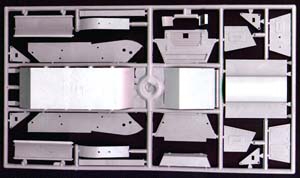 The
first light gray, medium sized tree, holds the body of the "Komsomolets"
tractor, The underside of the floor plate piece has "AER MOLDOVIA" molded,
in raised letters on it. This will...naturally...have to be sanded off.
The pour gates on these parts, where they attach to the sprue are rather
heavy. Solid flash appears in center of the sprue also. No locating pins
are on these parts... so they appear to have to be BUTT JOINED later when
you build the model. The rivet detail on these parts is nice though. 25
parts here.
The
first light gray, medium sized tree, holds the body of the "Komsomolets"
tractor, The underside of the floor plate piece has "AER MOLDOVIA" molded,
in raised letters on it. This will...naturally...have to be sanded off.
The pour gates on these parts, where they attach to the sprue are rather
heavy. Solid flash appears in center of the sprue also. No locating pins
are on these parts... so they appear to have to be BUTT JOINED later when
you build the model. The rivet detail on these parts is nice though. 25
parts here.
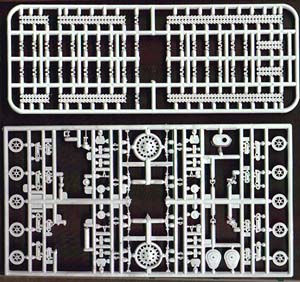 The
second light gray tree, of the same size, holds the running gear, road
wheels, drive sprockets, leaf springs, etc. The pour gates are more petite
on this tree. Strangely, only some of the parts have number tabs next
to them on this tree!! These tabs, that normally have numbers on them
in most other kits...are BLANK!! This does not bode well for when you
get around to building this kit!! 76 parts on this tree
The
second light gray tree, of the same size, holds the running gear, road
wheels, drive sprockets, leaf springs, etc. The pour gates are more petite
on this tree. Strangely, only some of the parts have number tabs next
to them on this tree!! These tabs, that normally have numbers on them
in most other kits...are BLANK!! This does not bode well for when you
get around to building this kit!! 76 parts on this tree
There is a slightly smaller, and a little lighter gray yet tree next. This holds the link and length type track links. These are rather TINY...but the "Komsomolets" tractor...itself...was a small vehicle. 36 parts here.
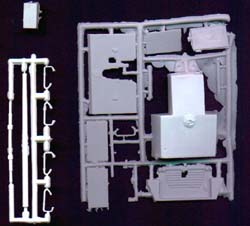 There
is a small tree... of what appears to be alternate body parts for the
"Komsomolets". There is massive flash all over the parts on this tree.
Count of parts on it is 11.
There
is a small tree... of what appears to be alternate body parts for the
"Komsomolets". There is massive flash all over the parts on this tree.
Count of parts on it is 11.
A snow white, tiny tree of parts holds grab handles, and the barrel for the Zis 30.
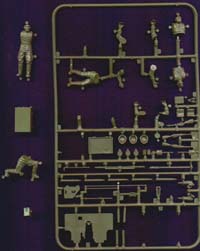 The
first of the olive gray trees contains three gun crew figures, their helmets
and side-arms, an ammo case...for the 57mm gun, five live ammo rounds,
four spent rounds, and some of the Zis 30's shields etc. 51 parts here.
The
first of the olive gray trees contains three gun crew figures, their helmets
and side-arms, an ammo case...for the 57mm gun, five live ammo rounds,
four spent rounds, and some of the Zis 30's shields etc. 51 parts here.
The second olive gray tree holds all the parts for the rest of the Zis 30 AT gun. 47 parts in all.
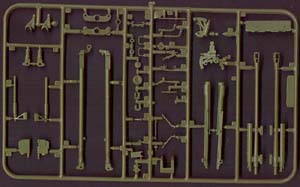 In
the olive gray parts is another gun barrel that has a muzzle brake...but
the instructions show to hack this off and use the white one with no muzzle
brake. The one with a muzzle is in two halves...the white one is one solid
piece. I notice that the box art seems to show that this barrel had no
taper...so I may just use aluminum tube or evergreen tubing the right
diameter for mine later. Six pieces here
In
the olive gray parts is another gun barrel that has a muzzle brake...but
the instructions show to hack this off and use the white one with no muzzle
brake. The one with a muzzle is in two halves...the white one is one solid
piece. I notice that the box art seems to show that this barrel had no
taper...so I may just use aluminum tube or evergreen tubing the right
diameter for mine later. Six pieces here
There are no decals in the kit. But...knowing usual Soviet practices during WWII...for marking their tanks...I doubt that this vehicle ever did have any markings. Maybe a slogan once in a while.
The instructions are a four page, 8 1/2" x 11" affair. The first page gives the history of the vehicle in Russian and English. The English has to be some of the worst grammar etc. that I have ever seen.
The second and third pages give the assembly drawings for the vehicle and gun. But there are no instructions covering the figures or their personal gear. There is also no painting guide...you will have to go by the box art! The part numbers of the parts are shown on the many exploded drawings. But, what good are they when approximately 50% of the parts on the trees are unnumbered and have to be identified by their shape on the drawings. These drawings are also very vague at times as to just where and how things are finally positioned once glued on the model...groan. It will really take some careful study and dry fitting to get this kit together right. The instructions dearly need to be redone. The fourth page of the instructions is totally blank. Maquette could have used this area to do a painting guide or assembly steps for the figures...There are no FORMAL numbered assembly steps by the way!
Conclusion
I think this kit will make up nice with a lot of work. It will be an unusual subject for sure, not seen too often. I have not encountered any tech data or pictures of it in any of my reference books here. Can any readers come to my rescue there?
With the reservations I already called out earlier, I would recommend this to modelers that have had a few crude Eastern European kits under their belts already. It sure is not a kit for the beginner!

Previous: Contents








